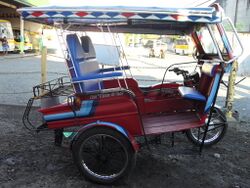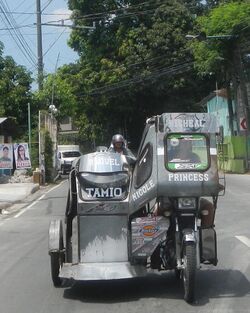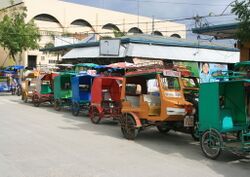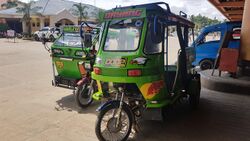Motorized tricycle (Philippines)
Topic: Engineering
 From HandWiki - Reading time: 5 min
From HandWiki - Reading time: 5 min
In the Philippines, motorized tricycles, or simply tricycles (Filipino: traysikel; Cebuano: traysikol), refer to a type of motorized vehicle consisting of a motorcycle and a passenger cab attached to it. Along with the jeepney, the Philippine tricycle is one of the most common means of public or private transportation in the country, especially in rural areas. These public utility vehicles either ply a set route or are for-hire, like taxis.[1]
Philippine tricycles are built in a variety of styles, which differ from city to city, and are usually made locally by building a sidecar and affixing it to an imported motorcycle. Usually both the cycle and sidecar are covered, but not always by the same roof. Larger companies, such as Fitcor Marketing, also manufacture passenger tricycles.[2] They are built with more seats, with the motor situated at the back rather than below the driver as per a motorcycle.
Philippine tricycles are often confused with the similar tuktuks and auto rickshaws of neighboring countries. Philippine tricycles evolved from motorcycles with sidecars used during World War 2 and are not derived from rickshaws. These tricycles also attach the passenger cab to the side of the motorcycle, in contrast to tuktuks, which are not motorcycles but factory-built three-wheelers. The motorela, a regional variant of the Philippine tricycle with a centered passenger cab enclosing the motorcycle, is the most visually similar to a tuktuk, but differs in that it has four wheels, not three. The passengers of a Motorola also sit sideways rather than face forward.
Origin
The exact date of the appearance of the tricycle in the Philippines is unknown, but it started appearing after World War 2, roughly at the same time as the appearance of the jeepney. It is most likely derived from the Rikuo Type 97 military motorcycle used by the Imperial Japanese Army in the Philippines starting at 1941. The motorcycle was essentially a licensed copy of a Harley-Davidson with a sidecar. However, there is also another hypothesis which places the origin of the tricycle to the similarly built "trisikad", a human-powered cycle rickshaw built in the same configuration as the tricycle. However, the provenance of the trisikad is also unknown. Prior to the tricycles and trisikad, the most common means of mass public transport in the Philippines is a carriage pulled by horses or carabaos known as the kalesa (calesa or carromata in Philippine Spanish).[3] The pulled rickshaw never gained acceptance in the Philippines. Americans tried to introduce it in the early 20th century, but it was strongly opposed by local Filipinos who viewed it as an undignified mode of transport that turned humans into "beasts".[4]
Passenger tricycles
Passenger tricycles can accommodate from four passengers up to as many as six or more, excluding the driver.[5] Goods can be placed on the roof. One or two passengers can sit behind the driver while several more can sit in the sidecar, depending upon the design. Additional passengers can sit on the roof or stand hanging onto the side or back of the sidecar. In rainy weather, a tricycle will be completely enclosed in heavy plastic covering.
Tricycles are often painted colorfully, like jeepneys.
Fares are less than taxi fares (if the city or municipality has taxis), yet more expensive than jeepney fares. Fares range from ₱10 to ₱250, depending on the locality and the distance to be ridden. Inside cities, tricycles often operate as shared taxis, where passenger fares are calculated per passenger and after the distance traveled. These fares are close to the fares of jeepneys. For longer journeys or in areas with heavy tourism, the driver will usually request that the passenger hire the whole tricycle and negotiate a "special fare", which will then be a private hire.[2]
In many urban areas, tricycles are gradually being substituted with Indian-built tuk-tuks[when?], known for their enhanced engines and spacious seating. Although not strictly classified as tricycles, these three-wheel vehicles are exempt from the tricycle ban on national highways, being treated separately from conventional tricycles. This exemption is due to their classification as three-wheelers rather than tricycles, allowing them to operate on national roads without restriction.[6]
Another noteworthy improvement in tricycle technology is observed in Manila. It is fully electric and distributed by a local company with major Japanese partnership.[7][8]
Motorela
The motorela, locally nicknamed as "the mini jeepney", is a variant of a motorized tricycle predominantly used in Northern Mindanao, particularly in Cagayan de Oro and Bukidnon province. It is a motorcycle with an enclosed cabin rigidly attached, and has four wheels – the two wheels of a motorcycle, and an additional wheel on each side. It has the capacity to carry more passengers than the traditional tricycle. The motorela was invented by Rafael D. Floirendo, a mechanic from Cagayan de Oro, in 1964.[9][10] Motorela comes from the words "motorized" and "caritela".[11]
Cargo tricycles
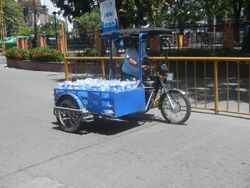
A variant of the tricycle used for carrying cargo is called garong or kolong kolong (also spelled kulong kulong, lit. "cage-like") in Tagalog. It is composed of a motorcycle attached to a sidecar made from welded metal pipes, bars, and/or sheet metal. The sidecar has a flat bed and usually has no seats or roofing. They are used widely, especially in public markets, to carry small-scale cargo like fish, vegetables, water bottles, and even live animals.[12][13][14]
See also
- Kalesa
- Auto rickshaw
- Tuktuk
References
- ↑ "Motorized Tricycles" (in en). http://www.boracay-budgettravel-tips.com/motorized-tricycles.html.; William C. Pollard, Jr., email to Lonely Planet, November 1, 2010, p. 2.
- ↑ 2.0 2.1 Bloom, Greg; Grosberg, Michael; Jealous, Virginia; Kelly, Piers (2009). Philippines. Lonely Planet. p. 450. ISBN 978-1741047219.
- ↑ "Filipino Icon: Tricycle and Pedicab" (in en). December 29, 2016. http://ffemagazine.com/filipino-icon-tricycle-pedicab/.
- ↑ Pante, Michael D. (2014). "Rickshaws and Filipinos: Transnational Meanings of Technology and Labor in American-Occupied Manila". International Review of Social History 59 (S22): 133–159. doi:10.1017/S0020859014000315.
- ↑ "Tricycles in Sorsogon" (in en). July 11, 2011. http://sorsogoncity.wordpress.com/2011/07/23/tricycles-in-sorsogon/.
- ↑ "New LTO memo reclassifies three-wheelers from tricycles - Motorcycle News" (in en). 27 November 2020. https://www.motopinas.com/motorcycle-news/new-lto-memo-reclassifies-three-wheelers-from-tricycles.html.
- ↑ "E.R.A.P. Manila Electric Tricycle Project: Second Batch of Beneficiaries Ready" (in en). September 29, 2017. https://newsbits.mb.com.ph/2017/09/29/e-r-a-p-manila-electric-tricycle-project/.
- ↑ "Tricycle Guide" (in en). https://adulttricyclespro.com/which-muscles-does-a-3-wheel-bike-work/.
- ↑ "Tricycle, Motorela & Habal-Habal" (in en). http://www.silent-gardens.com/tricycle.php.
- ↑ "Cagayan de Oro Transportation". cdoguide. January 26, 2009. http://www.cdoguide.com/goingaround/motorela.html.
- ↑ "Raphael Floirendo – the Motorela Inventor" (in en). March 18, 2010. http://www.cdodev.com/2010/03/18/raphael-floirendo-the-motorela-inventor/.
- ↑ "Kolong Kolong Tricycle". https://tricyclesphilippines.blog/2021/03/20/kolong-kolong-tricycle/.
- ↑ "Lalaking nagbibisikleta, patay nang masalpok ng 'garong'". BaliTamBayan. GMA News. 31 March 2021. https://www.gmanetwork.com/news/balitambayan/promdi/782049/lalaking-nagbibisikleta-patay-nang-masalpok-ng-garong/story/.
- ↑ "Executive Order No. 39". Office of the Mayor, Bayambang, Pangasinan. 26 June 2020. https://www.bayambang.gov.ph/wp-content/uploads/2020/07/EO-39-Bayambang-Public-Market.pdf.
External links
 |
 KSF
KSF